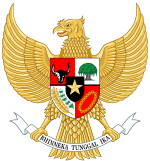
Pancasila economics (Indonesian: Ekonomi Pancasila), also known as "Indonesian populist economics" (Indonesian: Ekonomi kerakyatan Indonesia), is an economic system which aims to reflect the five principles of Pancasila.[1] The term "Pancasila economy" first appeared in an article by Emil Salim in 1967.[2] Mubyarto is one of the staunchest of the Pancasila economic theorists.
In essence, a Pancasila economy is a system that tries to avoid pendulum-like swings from one extreme (a free market economy, known in Indonesia as free fight liberalism) to the other (state socialism, especially of the Soviet kind). In simple terms, a "Pancasila economy" can be described as a market economic system with government control or a controlled market economy. A Pancasila economy can be considered an example of a mixed economy or a third way economic system.[2]
A Pancasila economy is seen as a counterbalance to a neoclassical approach promoting individualism and free markets[3] that is adapted the values of Indonesian society, including religious values, culture, customs and norms.[4]
The concept of Pancasila economics was first conceived in the early days of the New Order as part of the regime's De-Sukarnoization and "cleansing of Communist, 30 September Movement and PKI remnants from Pancasila" which was aimed for what the regime claim as a "return into a pure, consequential Pancasila".
- ^ "Macam dan Pengertian Sistem Ekonomi". www.ekonoomi.com. Archived from the original on 29 April 2014. Retrieved 15 May 2014.
- ^ a b Prof. Dr. Dawam Rahardjo. "Analisis Pancasila sebagai Filosofi Perekonomian". www.ekonomikerakyatan.ugm.ac.id. Retrieved 15 May 2014.
- ^ Mubyarto 2002, p. 68.
- ^ Cite error: The named reference
keempatwas invoked but never defined (see the help page).